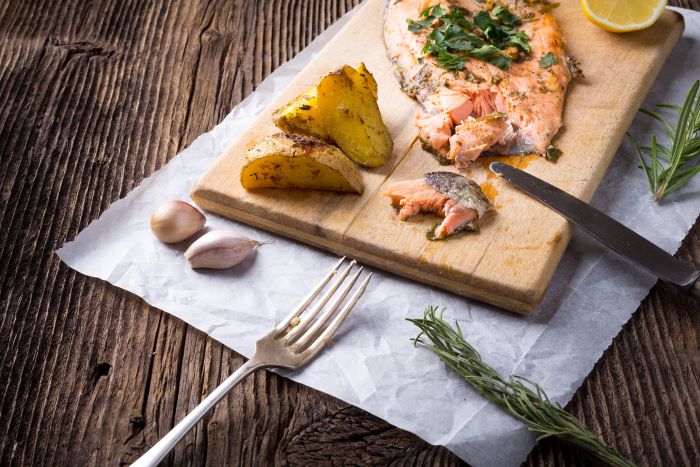Freshwater fish are tasty and nutritious, and recreational anglers can retain a number of fish each day, within the limits set by the regulations. In fact, part of the reason the Freshwater Fisheries Society of BC stocks lakes with trout, kokanee, and char is to supplement retention fisheries for the benefit of the public.
Rainbow trout have a light, mild flavour, and are delicious grilled, smoked, or baked. Generally, trout caught during the fall and spring will taste best. During the summer, you may not want to keep your catch, as some trout can develop a ‘muddy’ taste. This is due to chemical compounds released from blue/green algal blooms being absorbed through the skin of the trout.
Kokanee salmon – one of the species stocked by the Freshwater Fisheries Society of BC – are landlocked sockeye salmon, and share the rich colour and flavour of their sea-run relatives. They are typically found in large lakes where they head into deep water as the surface waters warm, residing well below algae blooms. This means that they continue to be excellent table fare throughout the summer months.
Another factor to consider when deciding to keep your catch is the age of the fish. Immature fish generally taste better than older fish. This video describes some signs to look for in determining the age of your catch:
If you plan on keeping your catch, here are some useful tips:
Harvesting Your Catch When You’re at the Water
- Decide what to do with a fish immediately after catching it. Fish are living creatures, and should always be treated humanely. In B.C., you are not allowed to retain fish in live wells. All fish that are not legally harvested must be released immediately.
- Clean fish promptly. Digestive enzymes can quickly spoil the flesh, making it taste bad. To comply with the law, you must leave the head, tail, and all fins on your catch until you get it home.
- Use clean water or premoistened wipes to clean your knife frequently and avoid transferring bacteria into the flesh.
- Once cleaned, wipe your fish with a cloth or paper towel, put it in a sealable storage bag, and store it in a cool place; a cooler full of ice is best. Do not put your catch in a plastic bag unless you can store it in a cool place; in warm temperatures, the sealed environment will quickly heat up and break down tissue.
Cleaning the Fish
- Using a sharp knife, insert the tip of the blade into the vent, and cut through the belly all the way to the gills

- Remove the guts.

- Scrape out the reddish-brown kidney, which lies along the backbone, with a small spoon.

Preparing and Storing Fish
- As you cut up your catch, clean your knife between cuts to avoid contaminating the fish. Wash your knife, hands, and cutting boards often with warm, soapy water, and then rinse thoroughly.
- Cut and package your fish into meal-sized portions, then freeze or refrigerate promptly.
- Fish you don’t plan to freeze should be stored in the refrigerator in a covered container, and used within two days.
- Keep refrigerated raw fish separated from cooked to prevent cross-contamination.
- Thaw frozen fish in the refrigerator, under cold running water, or in the microwave, and use immediately.
